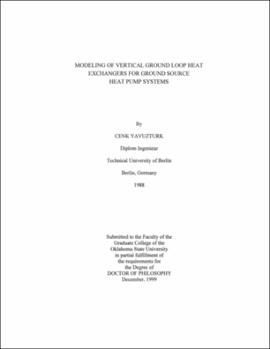| dc.contributor.advisor | Spitler, Jeffrey | |
| dc.contributor.author | Yavuzturk, Cenk | |
| dc.date.accessioned | 2023-03-20T22:03:38Z | |
| dc.date.available | 2023-03-20T22:03:38Z | |
| dc.date.issued | 1999-12 | |
| dc.identifier.uri | https://hdl.handle.net/11244/337138 | |
| dc.description.abstract | The ability to predict both the long-term and short-term behavior of ground loop
heat exchangers is critical to the design and energy analysis of ground source heat pump
systems. For detailed analysis and accurate simulation of the transient heat transfer in
vertical ground loop heat exchangers, a numerical model is developed. The model is
based on the two-dimensional, fully implicit finite volume formulation and utilizes an
automated parametric grid generation algorithm for different pipe sizes, shank spacing
and borehole geometry. The numerical method and grid generation techniques have been
validated against an analytical model. The numerical model has been developed with two
main purposes in mind. The first application is the calculation of non-dimensional
temperature response factors for short time scales that can be used in building simulation.
The second application is use in a parameter estimation technique used to predict
borehole ground formation thermal properties from short time scale test data. | |
| dc.description.abstract | The short-term behavior of ground-coupled heat pump systems is important for
the design of ground loop heat exchangers, the energy analysis of ground source heat
pump systems, and the design of hybrid ground source systems. Using short time-step
response factors, a direct evaluation of system energy consumption and electrical demand
in hourly or shorter time intervals becomes possible since a detailed assessment of the
ground heat exchanger behavior on an hour-by-hour basis can be performed. This is important especially when dealing with strong short time-step system fluctuations due to
building dynamics and for commercial buildings that have time-of-day electricity rates.
The short time-step model is cast as a TRNSYS component model and validated using
actual operating field data from an elementary school building located in Lincoln,
Nebraska. | |
| dc.description.abstract | Furthermore, a short time-step ground loop heat exchanger model is crucial for
analysis of hybrid ground source heat pump systems. Ground source heat pumps for
cooling-dominated commercial buildings utilize supplemental heat rejecters such as
cooling towers, fluid coolers or surface heat rejecters to reduce system first cost and to
improve system performance. The use of supplemental heat rejecters for cooling
dominated buildings allows the design of smaller borehole fields. Heat pump
performance degradation is avoided by offsetting the annual load imbalance in the
borefield and the resulting long-term temperature rise. Utilizing the short time-step
model, a parametric study is presented to investigate the advantages and the
disadvantages of various system operating and control strategies in a hybrid ground
source heat pump application under different climate conditions. An actual office
building located in Stillwater, Oklahoma is used as the example building. A preliminary
life cycle cost analysis is conducted to compare each operating and control strategy to
determine the lowest cost alternative for a given climate. | |
| dc.description.abstract | The numerical model is also used as part of parameter estimation algorithm that is
developed to predict borehole ground formation thermal properties from short time scale test data. Determination of the ground's thermal conductivity is a significant challenge
facing designers of Ground Source Heat Pump (GSHP) systems applied in commercial
buildings. The number of boreholes and the depth and cost of each borehole are highly
dependent on the ground thermal prope11ies. Hence, depending on the geographic
location and the local drilling costs, the ground thermal properties strongly influence the
initial cost to install a GSHP system. In order to be able to predict ground thermal
properties, a parameter estimation technique is employed that minimizes the sum of the
squares error between experimentally measured temperature responses and the
temperature predictions of the numerical model. An experimental apparatus has been
built capable of imposing a heat flux on a test borehole, and measuring its temperature
response. The downhill simplex method of Nelder and Mead (1969) in conjunction with
the two-dimensional numerical model is used to determine the thermal conductivity of
the surrounding ground. In order to validate the procedure, independent measurements of
the soil conductivity test results are reported for several test boreholes and a laboratory
experiment. A detailed uncertainty analysis of the thermal conductivity prediction is
conducted to assess the impact of uncertainty of a series of input parameters. | |
| dc.format | application/pdf | |
| dc.language | en_US | |
| dc.rights | Copyright is held by the author who has granted the Oklahoma State University Library the non-exclusive right to share this material in its institutional repository. Contact Digital Library Services at lib-dls@okstate.edu or 405-744-9161 for the permission policy on the use, reproduction or distribution of this material. | |
| dc.title | Modeling of vertical ground loop heat exchangers for ground source heat pump systems | |
| dc.contributor.committeeMember | Rees, Simon J. | |
| dc.contributor.committeeMember | Bose, James E. | |
| dc.contributor.committeeMember | Dalahoussaye, Ronald D. | |
| dc.contributor.committeeMember | Turner, Wayne C. | |
| dc.contributor.committeeMember | Dougherty, Ronald L. | |
| osu.filename | Thesis-1999D-Y35m.pdf | |
| osu.accesstype | Open Access | |
| dc.type.genre | Dissertation | |
| dc.type.material | Text | |
| dc.subject.keywords | heat pump | |
| dc.subject.keywords | ground source heat pump | |
| dc.subject.keywords | geothermal heat pump | |
| thesis.degree.discipline | Mechanical and Aerospace Engineering | |
| thesis.degree.grantor | Oklahoma State University | |
